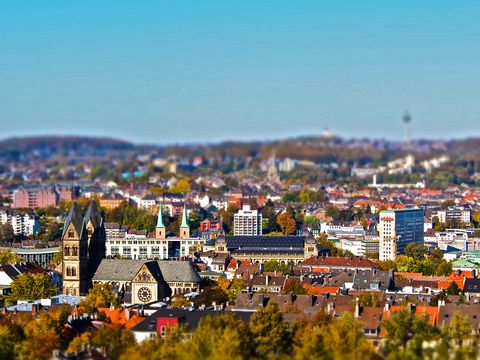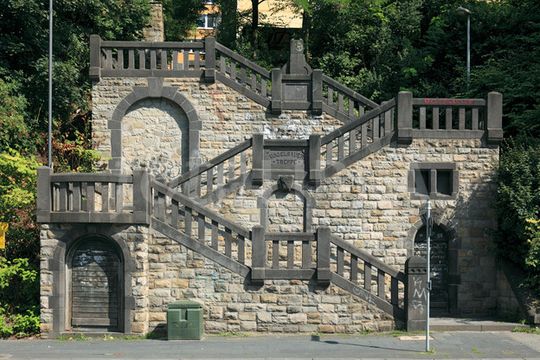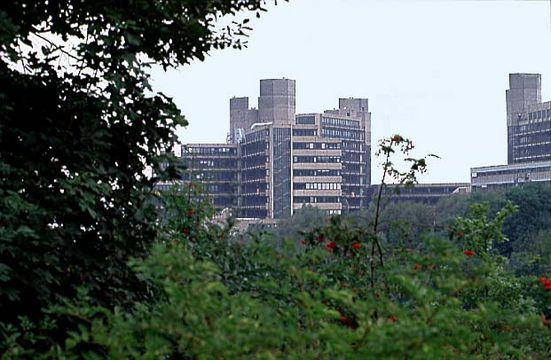#CityOfStairs #SuspensionRailway #MountainsAndHills
Wuppertal
A GREEN CITY NESTLED BETWEEN THE MOUNTAINS

Between the mountains and wooded areas, Wuppertal is a great place for recreation and relaxation. If you like hiking and enjoying nature, but also want the city-life experience, you’ll find ideal conditions for studying here. Other advantages include a compact campus and a very good infrastructure.
Facts
355,100 Inhabitants ¹
22,974 Students ²
2 Higher education institutions ²
WELCOME TO WUPPERTAL
There are two main things which Wuppertal offers – gardens and parks for relaxing and playing sports and a well-developed infrastructure with good traffic connections. Situated among numerous hills and small mountains, the city of Wuppertal is one of Germany’s largest student towns with some 350,000 inhabitants. It also has many surprises in store for you.
You probably won’t go a day in Wuppertal without climbing or descending at least one flight of stairs. There are about 500 stairways with a total of approx. 12,000 steps around the entire city. The best-known stairway in town is the “Tippen-Tappen-Tönchen“ (Tip-Tap Tones) which sounds like you’re walking up and down the stairs in wooden shoes. The longest stairway is the “Jakobstreppe” with 155 steps connecting the district of Elberfeld-West and Nützenberg, and the most impressive stairway – architecturally speaking – is the “Vogelsauer Treppe” in Elberfeld-West.
You also have to walk uphill to reach the University of Wuppertal. The university is situated on the Griffelberg in the southern part of the city. Even if you find the climb rather strenuous, once you’re at the university you’ll enjoy a great view over the Wupper Valley and the surrounding region. But don’t worry, there is a regular bus line that connects the campus to all the different quarters of the city.
This former industrial city looks back at an eventful history. Many of its historic buildings are located in the downtown district. The German philosopher Friedrich Engels is one of Wuppertal’s most famous sons; you can learn more about his life and achievements at the . The is worth visiting for its impressive architecture alone, as is the Wuppertal Stadthalle. You can enjoy the easy-going atmosphere of the city on a long stroll through downtown and the many gardens, parks and woods.
Tip
The Wuppertal Zoo is absolutely worth seeing. The grounds are very beautiful with impressive landscapes and lots of room for the animals. You could even forget that you’re in a big city!
One of the biggest attractions in Wuppertal is the which carries passengers 12 metres over and above the Wupper River from downtown to the surrounding city districts. The cars are suspended from a rail with wheels integrated into the roof which makes you feel as if you are floating in the air.
Interview
EVGENIYA FROM RUSSIA
LIVING IN WUPPERTAL
Even though the pulsating cities of and tend to “steal the show”, Wuppertal certainly has much to offer! At Laurentiusplatz and Luisenstrasse – Wuppertal’s “unofficial student quarter” – you’ll find all kinds of cafés and pubs where you are guaranteed to meet many other students. In the evening, you can go out to the unconventional Pina Bausch Dance Theatre or to one of Wuppertal’s clubs.
A major advantage of living in Wuppertal is its proximity to nature. You only need to take a short bike ride or public transport and you’ll find yourself in the Bergisches Land –a mountainous region nearby. You can go hiking, cycling and climbing in the surrounding area. The Ronsdorfer Reservoir is a popular destination only three kilometres away from Wuppertal. In the summer, you can go swimming in the lake or even camping with friends at the weekend at one of the surrounding camping areas.
Tags
#WineRegion #BaroquePomp #HistoricalCity


